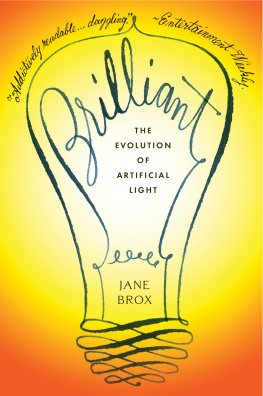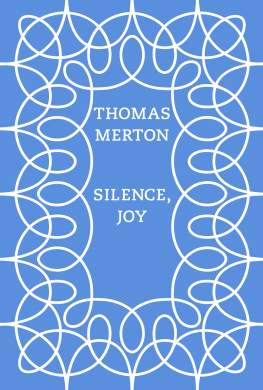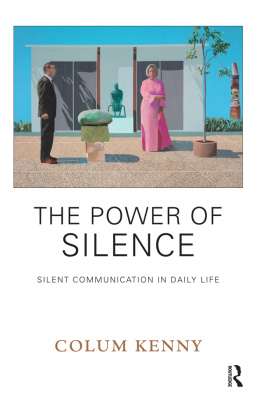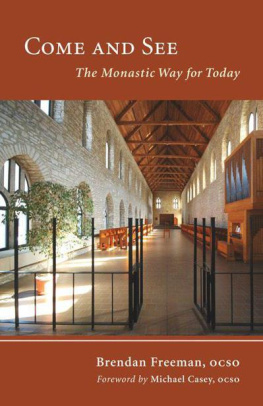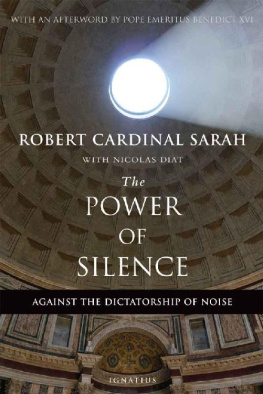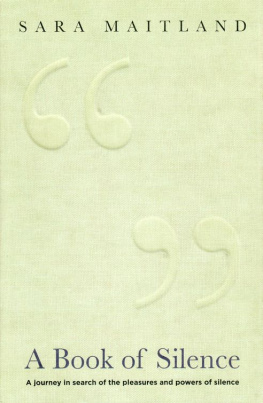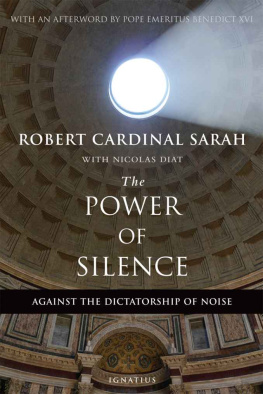Copyright 2019 by Jane Brox
All rights reserved
For information about permission to reproduce selections from this book, write to or to Permissions, Houghton Mifflin Harcourt Publishing Company, 3 Park Avenue, 19th Floor, New York, New York 10016.
hmhbooks.com
Library of Congress Cataloging-in-Publication Data
Names: Brox, Jane, 1956 author.
Title: Silence : a social history of one of the least understood elements of our lives / Jane Brox.
Description: Boston : Houghton Mifflin Harcourt, 2019. | Includes bibliographical references and index.
Identifiers: LCCN 2018017520 (print) | LCCN 2018029261 (ebook) | ISBN 9780544702516 (ebook) | ISBN 9780544702486 (hardcover)
Subjects: LCSH: SilenceHistory. | SilenceSocial aspects.
Classification: LCC BJ1499.S5 (ebook) | LCC BJ1499.S5 B76 2018 (print) | DDC 302/.1dc23
LC record available at https://lccn.loc.gov/2018017520
Cover design by Martha Kennedy
Cover photograph Gallery Stock
Author photograph Nicole Wolf
v1.1218
Funded in part by a grant from the Maine Arts Commission, an independent state agency supported by the National Endowment for the Arts.
Credits appear on page .
for
Cynthia Cannell
and for
Elizabeth Brown
Part 1
Philadelphias Eastern State Penitentiary, 1829: Experiment in Silence
Silence is as much a part of history as noise; the invisible as much a part of history as the visible.
Max Picard, The World of Silence
1
Man of Sorrows
I first saw the granite faade of Eastern State Penitentiary on a cold November weekday. I could feel the chill off the rivers. Fairmount Avenue was quiet under a gray sky. The nineteenth-century row houses and the narrow, numbered streets intersecting the avenue were quiet, too, in the afterlifeafter the factories, foundries, lumberyards, coal yards, lime kilns, and breweries; after the waves of Irish, German, Polish, and Ukrainian immigrants.
Although today there are white tablecloths and fresh flowers in the restaurants of the Fairmount neighborhood and one of the breweries has become an upscale condominium, the Mid-Atlantic light falls differently on the old working-class streets than it does on the soft red brick of colonial Philadelphia a few miles away. The older part of the city, with its greenery, manila-trimmed windows, and cobblestones, feels swept clean and inhabited by the effort at preservation. Fairmount suggests that the past is still mutable, perhaps because the penitentiary, rather than being preserved, has been stabilized in its slide toward ruin. Some walls and ceilings have been shored up for safety, and a few early cells have been reconstructed, but mostly its successive histories have collapsed together to create a somber half deterioration. Visitors walk through a world of sunken roofs, rubble, peeling paint, weeds, and weed treesthe detritus of what had once been a dream of order.
The penitentiary isnt as old as it feels. Construction began in 1822, with the intent of providing for the separate and silent incarceration of housebreakers, forgers, highway robbers, horse thieves, and murderers from the eastern counties of Pennsylvania. Not only were the prisoners to remain in their individual cells for the duration of their sentences, but once they passed through the portal their isolation was to be nearly complete. The board of inspectors for Philadelphias prisons at the time called for such an entire seclusion of convicts from society and from one another, as that during the period of their confinement, no one shall see or hear, or be seen or heard by any human being, except the jailer, the inspectors, or such other persons, as for highly urgent reasons may be permitted to enter the walls of the prison.
The concept of such extreme silence and solitudefirst articulated more than thirty-five years before the cornerstone for the penitentiary was laidwas the vision of Founding Father Benjamin Rush, a well-known public figure in post-Revolutionary Philadelphia. Rush was the citys most prominent physician, an ardent abolitionist, a proponent of hospital reform, and a supporter of the earliest efforts to create a comprehensive public school system. During the last decades of the eighteenth century, he took a particular interest in criminal justice at a time when legislators in the new Republic were seeking to develop a penal code distinct from old-world punishments. His idea for a penitentiaryambitious, entirely new for its timewould require persistence to see it to fruition, and Rush would need to garner the support of friends and prison advocates who could help him lay decades of groundwork.
The Fairmount neighborhood was still open country when the construction of Eastern State began. Its advocates wanted a rural site to abet the circulation of fresh air and the removal of sewage, and for the sheer space that solitude and silence for hundreds required. It would also stand in contrast to the old jails that often stood in the hearts of towns, where the division between the incarcerated and the free was permeable. There jail windows opened onto the streets, and the jailed could call out to passersby or beg for a little money. Friends of the imprisoned might bring them news and food and drink.
The building commission that oversaw the project had chosen to erect the penitentiary on the site of a modest farm that spanned a small hillside on the outskirts of Philadelphia. Workers tore down or hauled away all its holdings: the cherry orchard (the penitentiary would come to be known as Cherry Hill), the stables and house, the stone troughs, the copper boiler in the milk room. The ten cleared acres then became the site of one of the largest construction projects to be undertaken in early-nineteenth-century America, with a massive wall enclosing most of what was needed to maintain the daily life of hundreds: seven ranges of cells, workshops, storerooms, gardens, a kitchen, a bakery, a laundry room, an apothecarys shop, and a hospital ward for the prisoners; quarters for the prison keepers, the warden, and the watchmen.
The rural location also meant that anyone who approachedprisoners or passersbywould gain a long view of the penitentiarys parapets, Norman-style guard towers, and thirty-foot-high wall built of hewn, squared Schuylkill stone, all of which were meant, the building commissioners declared, to convey to the mind a cheerless blank indicative of the misery that awaits the unhappy being who enters within its walls.
Now that the city has entirely surrounded the penitentiarythe house for the silent proved to be more enduring than the agricultural world it once imposed itself uponits wall stands at nearly the same height as the surrounding row houses. I didnt notice it until I came upon it. Vines climb it; a lone tree has gotten a purchase on a capstone; the gray stone is stained with black grit and soot. Still, the one entryway stands massive and imposing. Let its doors be of iron, Benjamin Rush declared, and let the grating, occasioned by opening and shutting them, be encreased by an echo from a neighboring mountain, that shall extend and continue a sound that shall deeply pierce the soul.
The original entryway stood twenty-seven feet high and fifteen feet wide. Its oaken double doors, studded with iron rivets, weighed several tons, and a wrought-iron portcullis fronted them. When they were replaced by an electrically operated door in 1938, the wooden planks were burned on the prison grounds, the rivets given away as souvenirs. The door may be different now, but it is still the only entry to the penitentiary, and I trod upon the same stones as the seventy-five thousand prisoners who served their time at Eastern State and all the visitors of nearly two centuries. Once through, I wandered among its decaying corridors with a handful of other visitors, most wearing earphones and listening to a tour tape, trying to match what they have heard to the collapses and rubble, to a place no longer prey to the force of ideas or hopes of control.

